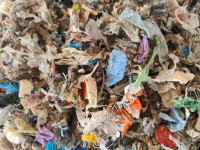The cement industry is responsible for around 8 per cent of global greenhouse gas emissions - almost three times as much as global air traffic (3 per cent). At the same time, the demand for cement has been increasing for years. The industry is therefore actively looking for ways to reduce its greenhouse gas emissions.
Cement production is doubly CO2-intensive
Around one third of greenhouse gas emissions in the production of cement is energy-related and just under two thirds are process-related. The process-related emissions come from the processed rock itself during burning and are therefore virtually unavoidable. They have to be separated and neutralised, which is still technically challenging and associated with high costs.
The industry is therefore looking all the more for solutions to reduce energy-related emissions as much as possible and not to heat the kilns to 1600°C using coal or other fossil fuels. After all, the firing of cement kilns produces almost one billion tonnes of CO2e per year worldwide.
Utilisation of refuse and waste heat
The idea of not simply burning combustible waste in a waste incineration plant but utilising the resulting energy for industrial purposes is not new. In fact, it is now so popular that companies have to pay a lot of money for this alternative fuel (AF) - especially if it is highly combustible. ‘Highly combustible’ means, among other things, ‘dry’.
Wet waste, on the other hand, is still quite cheap because it has to be dried before it can be burnt. Very conveniently, the cement industry has waste heat available in the form of hot air which can be used to dry the wet waste!
And this is exactly where the KUVO from SWISS COMBI comes into play.
Burning cement with wet waste (RDF) - this is how it works
RDF (Refuse-Derived Fuel), i.e. combustible waste such as plastic, wood, paper/cardboard, textiles, etc., is used as a substitute fuel. This waste must first be shredded so that it can be distributed evenly on the dryer. Our KUVO is a belt dryer that has been specifically designed to utilise hot air. And there is plenty of it in the cement industry, because the cement has to be cooled down after burning.
This produces hot air at a temperature of up to 200°C - far too much to dry the wet waste directly. Plastic, for example, would melt at this temperature. That's why we mix the hot waste air with outside air so thoroughly that it cools down to 90°C and no hot strands form anywhere. These could easily lead to fires. Only then is the homogenised air fed into the KUVO.
In the KUVO, the waste is then dried to a residual moisture of around 15 per cent and can then be used in the kiln as a low-cost, non-fossil fuel.
If you are interested in drying Refuse-Derived Fuels (RDF) or Alternative Fuels (AF), please contact us!

